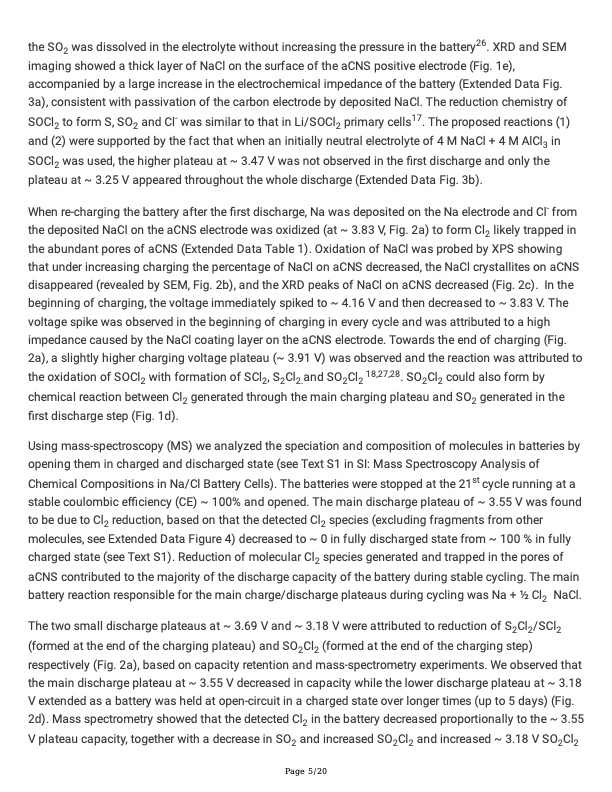
PDF Publication Title:
Text from PDF Page: 005
the SO2 was dissolved in the electrolyte without increasing the pressure in the battery26. XRD and SEM imaging showed a thick layer of NaCl on the surface of the aCNS positive electrode (Fig. 1e), accompanied by a large increase in the electrochemical impedance of the battery (Extended Data Fig. 3a), consistent with passivation of the carbon electrode by deposited NaCl. The reduction chemistry of SOCl2 to form S, SO2 and Cl- was similar to that in Li/SOCl2 primary cells17. The proposed reactions (1) and (2) were supported by the fact that when an initially neutral electrolyte of 4 M NaCl + 4 M AlCl3 in SOCl2 was used, the higher plateau at ~ 3.47 V was not observed in the �rst discharge and only the plateau at ~ 3.25 V appeared throughout the whole discharge (Extended Data Fig. 3b). When re-charging the battery after the �rst discharge, Na was deposited on the Na electrode and Cl- from the deposited NaCl on the aCNS electrode was oxidized (at ~ 3.83 V, Fig. 2a) to form Cl2 likely trapped in the abundant pores of aCNS (Extended Data Table 1). Oxidation of NaCl was probed by XPS showing that under increasing charging the percentage of NaCl on aCNS decreased, the NaCl crystallites on aCNS disappeared (revealed by SEM, Fig. 2b), and the XRD peaks of NaCl on aCNS decreased (Fig. 2c). In the beginning of charging, the voltage immediately spiked to ~ 4.16 V and then decreased to ~ 3.83 V. The voltage spike was observed in the beginning of charging in every cycle and was attributed to a high impedance caused by the NaCl coating layer on the aCNS electrode. Towards the end of charging (Fig. 2a), a slightly higher charging voltage plateau (~ 3.91 V) was observed and the reaction was attributed to the oxidation of SOCl2 with formation of SCl2, S2Cl2.and SO2Cl2 18,27,28. SO2Cl2 could also form by chemical reaction between Cl2 generated through the main charging plateau and SO2 generated in the �rst discharge step (Fig. 1d). Using mass-spectroscopy (MS) we analyzed the speciation and composition of molecules in batteries by opening them in charged and discharged state (see Text S1 in SI: Mass Spectroscopy Analysis of Chemical Compositions in Na/Cl Battery Cells). The batteries were stopped at the 21st cycle running at a stable coulombic e�ciency (CE) ~ 100% and opened. The main discharge plateau of ~ 3.55 V was found to be due to Cl2 reduction, based on that the detected Cl2 species (excluding fragments from other molecules, see Extended Data Figure 4) decreased to ~ 0 in fully discharged state from ~ 100 % in fully charged state (see Text S1). Reduction of molecular Cl2 species generated and trapped in the pores of aCNS contributed to the majority of the discharge capacity of the battery during stable cycling. The main batteryreactionresponsibleforthemaincharge/dischargeplateausduringcyclingwasNa+1⁄2Cl2 NaCl. The two small discharge plateaus at ~ 3.69 V and ~ 3.18 V were attributed to reduction of S2Cl2/SCl2 (formed at the end of the charging plateau) and SO2Cl2 (formed at the end of the charging step) respectively (Fig. 2a), based on capacity retention and mass-spectrometry experiments. We observed that the main discharge plateau at ~ 3.55 V decreased in capacity while the lower discharge plateau at ~ 3.18 V extended as a battery was held at open-circuit in a charged state over longer times (up to 5 days) (Fig. 2d). Mass spectrometry showed that the detected Cl2 in the battery decreased proportionally to the ~ 3.55 V plateau capacity, together with a decrease in SO2 and increased SO2Cl2 and increased ~ 3.18 V SO2Cl2 Page 5/20PDF Image | Rechargeable NaCl Battery Hongjie

PDF Search Title:
Rechargeable NaCl Battery HongjieOriginal File Name Searched:
A_Rechargeable_NaCl_Battery.pdfDIY PDF Search: Google It | Yahoo | Bing
Product and Development Focus for Salgenx
Redox Flow Battery Technology: With the advent of the new USA tax credits for producing and selling batteries ($35/kW) we are focussing on a simple flow battery using shipping containers as the modular electrolyte storage units with tax credits up to $140,000 per system. Our main focus is on the salt battery. This battery can be used for both thermal and electrical storage applications. We call it the Cogeneration Battery or Cogen Battery. One project is converting salt (brine) based water conditioners to simultaneously produce power. In addition, there are many opportunities to extract Lithium from brine (salt lakes, groundwater, and producer water).Salt water or brine are huge sources for lithium. Most of the worlds lithium is acquired from a brine source. It's even in seawater in a low concentration. Brine is also a byproduct of huge powerplants, which can now use that as an electrolyte and a huge flow battery (which allows storage at the source).We welcome any business and equipment inquiries, as well as licensing our flow battery manufacturing.| CONTACT TEL: 608-238-6001 Email: greg@salgenx.com | RSS | AMP |